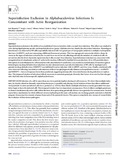Mostrar el registro sencillo del ítem
Superinfection exclusion in alphabaculovirus infections is concomitant with actin reorganization
| dc.creator | Beperet Arive, Inés | es_ES |
| dc.creator | Irons, Sarah L. | es_ES |
| dc.creator | Simón de Goñi, Oihane | es_ES |
| dc.creator | King, Linda A. | es_ES |
| dc.creator | Williams, Trevor | es_ES |
| dc.creator | Possee, Robert D. | es_ES |
| dc.creator | López Ferber, Miguel | es_ES |
| dc.creator | Caballero Murillo, Primitivo | es_ES |
| dc.date.accessioned | 2019-01-21T13:24:48Z | |
| dc.date.available | 2019-01-21T13:24:48Z | |
| dc.date.issued | 2014 | |
| dc.identifier.issn | 0022-538X (Print) | |
| dc.identifier.issn | 1098-5514 (Electronic) | |
| dc.identifier.uri | https://hdl.handle.net/2454/32037 | |
| dc.description.abstract | Superinfection exclusion is the ability of an established virus to interfere with a second virus infection. This effect was studied in vitro during lepidopteran-specific nucleopolyhedrovirus (genus Alphabaculovirus, family Baculoviridae) infection. Homologous interference was detected in Sf9 cells sequentially infected with two genotypes of Autographa californica multiple nucleopolyhedrovirus (AcMNPV), each one expressing a different fluorescent protein. This was a progressive process in which a sharp decrease in the signs of infection caused by the second virus was observed, affecting not only the number of coinfected cells observed, but also the level of protein expression due to the second virus infection. Superinfection exclusion was concurrent with reorganization of cytoplasmic actin to F-actin in the nucleus, followed by budded virus production (16 to 20 h postinfection). Disruption of actin filaments by cell treatment with cytochalasin D resulted in a successful second infection. Protection against heterologous nucleopolyhedrovirus infection was also demonstrated, as productive infection of Sf9 cells by Spodoptera frugiperda nucleopolyhedrovirus (SfMNPV) was inhibited by prior infection with AcMNPV, and vice versa. Finally, coinfected cells were observed following inoculation with mixtures of these two phylogenetically distant nucleopolyhedroviruses—AcMNPV and SfMNPV—but at a frequency lower than predicted, suggesting interspecific virus interference during infection or replication. The temporal window of infection is likely necessary to maintain genotypic diversity that favors virus survival but also permits dual infection by heterospecific alphabaculoviruses. | en |
| dc.description.sponsorship | I.B. received a CSIC studentship. This research was supported by the project AGL2011-30352-CO2-01 (Universidad Pública de Navarra, Pamplona, Spain) and Oxford Brookes University, Oxford, United Kingdom. | en |
| dc.format.extent | 9 p. | |
| dc.format.mimetype | application/pdf | en |
| dc.language.iso | eng | en |
| dc.publisher | American Society for Microbiology | en |
| dc.relation.ispartof | Journal of Virology, March 2014 Volume 88 Number 6, p. 3548–3556 | en |
| dc.rights | © 2014, American Society for Microbiology. All Rights Reserved. | en |
| dc.subject | Superinfection exclusion | en |
| dc.subject | Nucleopolyhedroviruses | en |
| dc.subject | Alphabaculovirus infections | en |
| dc.subject | Actin reorganization | en |
| dc.title | Superinfection exclusion in alphabaculovirus infections is concomitant with actin reorganization | en |
| dc.type | info:eu-repo/semantics/article | en |
| dc.type | Artículo / Artikulua | es |
| dc.contributor.department | Producción Agraria | es_ES |
| dc.contributor.department | Nekazaritza Ekoizpena | eu |
| dc.contributor.department | IdAB. Instituto de Agrobiotecnología / Agrobioteknologiako Institutua | es |
| dc.rights.accessRights | info:eu-repo/semantics/openAccess | en |
| dc.rights.accessRights | Acceso abierto / Sarbide irekia | es |
| dc.identifier.doi | 10.1128/jvi.02974-13 | |
| dc.relation.projectID | info:eu-repo/grantAgreement/MICINN//AGL2011-30352-C02-01/ES/ | en |
| dc.relation.publisherversion | https://doi.org/10.1128/jvi.02974-13 | |
| dc.type.version | info:eu-repo/semantics/publishedVersion | en |
| dc.type.version | Versión publicada / Argitaratu den bertsioa | es |


